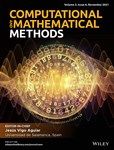Controlling crop pest with a farming awareness based integrated approach and optimal control
Funding information: Adama Science and Technology University (ASTU), ASTU/SP-R/027/19; Fundação para a Ciência e a Tecnologia, UIDB/04106/2020
Abstract
We investigate a mathematical model in crop pest controlling, considering plant biomass, pest, and the effect of farming awareness. The pest population is divided into two compartments: susceptible pests and infected pests. We assume that the growth rate of self-aware people is proportional to the density of susceptible pests existing in the crop arena. Impacts of awareness are modeled through the usual mass action term and a saturated term. It is further assumed that self-aware people will adopt chemical and biological control methods, namely, integrated pest management. Bio-pesticides are costly and require a long-term process, expensive to impose. However, if chemical pesticides are introduced in the farming system along with bio-pesticides, the process will be faster as well as cost-effective. Also, farming knowledge is equally important. In this article, a mathematical model is derived for controlling crop pests through an awareness-based integrated approach. In order to reduce the negative effects of pesticides, we apply optimal control theory.
1 INTRODUCTION
Problems connected with pests have become evident around the world as cultivation began. World's food supply is being wasted due to the cause of pests in agriculture. On the other hand, major side-effects of synthetic pesticides on the environment, human health, and biodiversity are generating widespread concerns. Thus, farmers' awareness of the risk of synthetic pesticides uses is one of the important factors to consider. The use of biological contents to protect crops against pests needs indigenous knowledge to implement such contents in pest management.1, 2
There are several good modeling studies on pest control. For example, Chowdhury et al.3, 4 have proposed and analyzed mathematical models for biological pest control using the virus as a controlling agent. In fact, all eco-epidemic models with susceptible prey, infected prey, and predators can be used to discuss the nature of the susceptible pest, infected pest, and their predators.5 Zhang et al.6 used a delayed stage-structured epidemic model for pest management strategy. Wang and Song7 used mathematical models to control a pest population by infected pests. However, they did not use the influence of the predator populations on their works.
Many researchers utilize mathematical models for pest control in order to study different aspects of pest management policies with probable outcomes for improved applications, using system's analysis within the mathematical paradigm. Most of them suggest using chemical pesticides.8, 9 However, it is recorded that chemical pesticides have resulted in pest resurgence, acute and chronic health problems, and environmental pollution.10 Thus, to resolve this type of problem, the concept of IPM is becoming more popular among researchers with increasing application in the field by marginal farmers.
In this article, we formulate a mathematical model, incorporating the farming awareness based integrated approach. The main focus is to compare the basic advantage of favoring the biological and combined strategy to minimize the pest problem and predict new insights on the pest management, in general. In order to reduce the negative effects of pesticides, we apply an optimal control approach. The dynamic of the system, without application of control, is analyzed through stability and bifurcation theory. Then, we formulate a three control parameter optimal control problem and solve it by applying PMP to find out the optimal level of both pesticide and the advertisement cost for cost effectiveness and minimizing the negative effect due to pesticides. Numerical simulations illustrate the analytical results. Finally, we discuss the outcomes with a conclusion.
2 DESCRIPTION AND MODEL FORMULATION
- Under influence of bio-pesticides, healthy pest population becomes infected. Infected pest can attack the plant but the rate is very lesser than susceptible pest. We assume that infected pest can consume the plant biomass following a Holling type II response, whereas susceptible pest consume following a Holling type I response function.
- Due to the finite size of crop field, we assume logistic growth for the density of crop biomass, with net growth rate r and carrying capacity K.
- Susceptible attacks the crop, thereby causing considerable crop reduction. If we infect the susceptible pest by pesticides, then the attack by pest can be controlled. Here we assume that aware farmers will adopt biological pesticides for the control of the crop pest, as it has less side effects and is also environment friendly. Biopesticides are used to infect the healthy pest. Infected pest has an additional mortality due to infection.
- Let be the consumption rate of pests. There is a pest infection rate, , because of aware human interactions and activity such as use of biopesticides (e.g., NPV), modeled via the usual mass action term . We denote by d the natural mortality rate of pest and by the additional mortality rate of infected pest due to aware people activity.
- It is assumed that the level of awareness will increase at a rate , proportional to the number of pests per plant noticed in the farming system. There could be fading of interest in this exploitation. We let be the rate of fading of interest of aware people.
- To speed up the pest control process, chemical synthetic pesticides are introduced. It causes additional death to both susceptible and infected pest populations. Following Reference 11, we model the situation by the terms and , respectively.
3 POSITIVITY OF SOLUTIONS AND THE INVARIANT REGION
Existence and positivity of the solutions are the main properties that system (1) must satisfy for the model to be well-posed. Such properties are proved in this section. They describe the range in which the solution of the equations is biologically important.
Lemma 1.Any solution of the differential equation is always positive.
Proof.A differential equation of the form can be written as . Integrating, we can write that , that is, we have for .
Theorem 1. (Non-negativeness of the solutions)The solutions of system (1) subject to given non-negative initial conditions (2) remain non-negative for all .
Proof.Let be a solution of system (1) with its initial conditions (2). We use Lemma 1 to prove the positivity of the equations in the system. Let us consider for . We obtain, from the first equation of system (1), that
Theorem 2. (Boundedness of solutions)Every solution of system (1) that start in is uniformly bounded in the region defined by
Proof.We choose , because in our assumptions we assume that . Now, at any time t, let . Then the time derivative of W along the solution of system (1) is given by
4 EQUILIBRIA ASSESSMENT
- (i)
The axial equilibrium point , which always exists.
- (ii)
The pest free equilibrium point , which, again, always exists.
- (iii)
The boundary equilibrium point , where
and is the positive root of the equation . Unfortunately, this quadratic equation has no positive roots and, hence, such an equilibrium does not occur. - (iv)
The healthy pest free equilibrium point , where , , and are computed as follows. If we set in system (4), then
()From the first equation of the nonlinear system (5), we haveand, from the third equation of system (5), we getFinally, solving for X from the second equation of system (5), we see that is the positive root of equation()whereThe model system (1) may have one or more healthy pest free equilibrium points , depending on the positive solutions of Equation (6). The healthy pest free equilibrium point exists only if Equation (6) has a positive root and . - (v)
Our model system (1) has an equilibrium point in the presence of pest, , , , , called the interior or coexistence or endemic equilibrium point, which is denoted by . Note that is the steady state solution where pest persist in the crop biomass population. It is obtained by setting each equation of system (1) equal to zero, that is,
From the second equation of system (4), we get , that is, , from which we obtainFrom the first equation of system (4), we have()and from the last equation of system (4) we get()Solving Equations (7) and (8) simultaneously, one obtainsTherefore, is the coexistence steady state withand a positive root of equation()whose coefficients are given byThe coexistence equilibrium point exists only if the characteristic equation (9) has a positive root in A with .
5 STABILITY OF THE EQUILIBRIA
Theorem 3. (Stability of the crop-pest free equilibrium)The system is always unstable around the crop-pest free equilibrium point .
Proof.The Jacobian matrix (10) at the crop-pest free equilibrium is given by
Theorem 4. (Stability of the pest free equilibrium)The pest free steady state is locally asymptotically stable if the two critical parameters and ,
Proof.The Jacobian matrix , at the pest free equilibrium point , is given by
The conditions for stability of the pest free equilibrium point indicate that if the attack rate of the pest population is low, then the system may stabilize to the pest free steady state.
Theorem 5. (Stability of the healthy pest free equilibrium)The healthy pest free equilibrium is locally asymptotically stable if, and only if,
- (i)
,
- (ii)
, ,
- (iii)
,
where
Proof.At the healthy pest free fixed point , the Jacobian matrix is given by
- (i)
;
- (ii)
;
- (iii)
.
The proof is complete.
Theorem 6. (Stability of the interior equilibrium point)System (1) at the interior equilibrium point is locally asymptotically stable if, and only if,
Proof.The Jacobian matrix at the coexistence equilibrium point is given by
Next, we shall find out conditions for which the system enters into Hopf bifurcation around the interior equilibrium . We focus on the pest consumption rate , which is considered as the most biologically significant parameter.
6 HOPF-BIFURCATION
- (i)
There exists at which a pair of complex eigenvalues are such that
with transversality condition - (ii)
All other elements of have negative real parts.
We obtain the following result.
Theorem 7. (Hopf bifurcation around the interior equilibrium with respect to the pest consumption rate )Let be given as in (20) and let be such that . System (1) enters into a Hopf bifurcation around the coexistence equilibrium at if and only if , where
Proof.The critical value is obtained from the equation . For , we have
We have restricted ourselves here to study the Hopf bifurcation around the interior equilibrium point with respect to the pest consumption rate , because it is the most biologically significant parameter. However, by replacing by other model parameters, such as , , or , one can also study the Hopf bifurcation around the interior equilibrium point with respect to such parameters of the model.
7 THE OPTIMAL CONTROL PROBLEM
7.1 Existence of solution
- (i)
The set of trajectories to system (28)–(29) on the admissible class of controls (32) is non-empty.
- (ii)
The set where the controls take values is convex and closed.
- (iii)
Each right-hand side of the state system (28) is continuous, is bounded above by a sum of the bounded control and the state, and can be written as a linear function of u with coefficients depending on time and the state variables.
- (iv)
The integrand of the objective functional (30) is convex with respect to the control variables.
- (v)
There exist positive numbers and a constant such that
We obtain the following existence result.
Theorem 8.Consider the optimal control problem defined by: the objective functional (30) on (32); the control system (28); and nonnegative initial conditions (29). Then there exists an optimal control triple and corresponding state trajectory such that subject to (28)–(29).
Proof.The proof is done verifying each of the five items (i)–(v) stated above.
- (i)
Since is a nonempty set of real valued measurable functions on the finite time interval , the system (28) has bounded coefficients and hence any solutions are bounded on (see Theorem 2). It follows that the corresponding solutions for system (28)–(29) exist.15
- (ii)
In our case, the set where the admissible controls take values is , which is clearly a convex and closed set.
- (iii)
The right-hand sides of equations of system (28) are continuous. All variables , and u are bounded on and can be written as a linear function of and with coefficients depending on time and state variables.
- (iv)
The integrand of (30) is quadratic with respect to the control variables, so it is trivially convex.
- (v)
Finally, it remains to show that there exists a constant and positive constants , and such that
In Section 2, we already showed that the state variables are bounded. Let , , , , and . It follows that
We conclude that there exists an optimal control triple.12
7.2 Characterization of the solution
Theorem 9.If the controls and the corresponding trajectories are optimal, then there exist adjoint variables , , , and satisfying the system of equations
Proof.The result is a direct consequence of the PMP.
7.3 The method to solve the optimal control problem
| Parameters | Description | Value | Source |
|---|---|---|---|
| r | Growth rate of crop biomass | 0.05 per day | 17 |
| K | Maximum density of crop biomass | 1 m | 1 |
| Aware people activity rate | 0.025 per day | 5 | |
| d | Natural mortality of pest | 0.01 day | 1 |
| Conversion efficacy of susceptible pests | 0.8 | 5 | |
| Conversion efficiency of infected pest | 0.6 | 5 | |
| Disease related mortality rate | 0.1 per day | 1 | |
| a | Half saturation constant | 0.2 | 17 |
| Attack rate of pest | 0.025 pestper day | 5 | |
| Local rate of increase of awareness | 0.015 per day | Assumed | |
| The increase of level from global advertisement | 0.025 | 4 | |
| Fading of memory of aware people | 0.015 day | 17 | |
| Rate of global awareness (via TV, radio) | 0.003 day | Assumed |
In Section 8, we solve the optimal control problem numerically and observe the behavior of some solutions as time varies.
8 NUMERICAL SIMULATIONS
Since the analytical solution of system (1) is not practical to analyze, the numerical results play a great role in characterizing the dynamics. Our numerical simulations show how realistic our results are and illustrate well the predicted analytical behavior. We begin by analyzing system (1) without controls, then our control system (28) subject to the optimal controls, as characterized by the PMP. Our numerical simulations are acquired with a set of parameter values as given in Table 1. For our numerical experiments of the uncontrolled system, we take days; while for the numerical simulations of the optimal control problem we fix days. The values of the weight function are taken as , , , , and , and the initial state variables as , , , . In Figures 1 and 2, the time series solution of model system (1) are sketched with different values of the parameters and . It is observed that our model variables , , , and become oscillating as the values of the rates (i.e., and ) get larger and finally become stable. Also, the steady state value of both pest population (when they exist) are decreased as and rise. A bifurcation illustration is shown in Figure 3, taking as the main parameter.
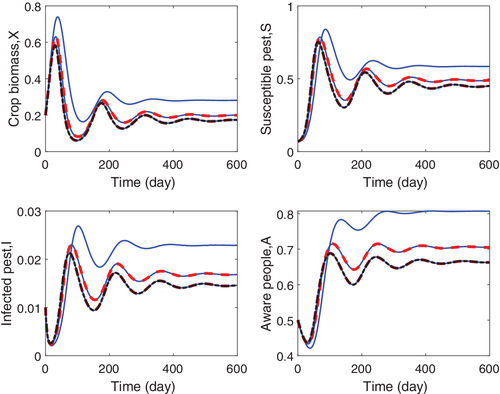
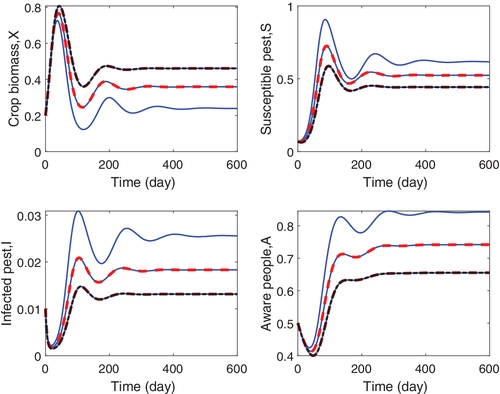
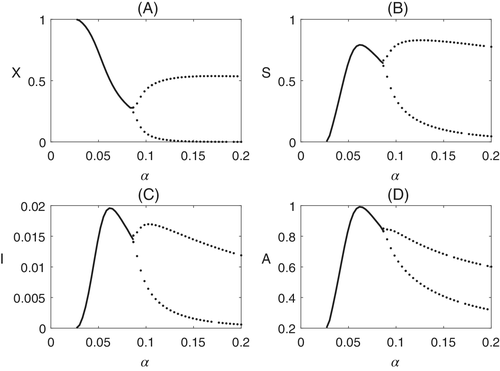
Critical values depend on many parameters, such as the conversion rates and , the rate of the awareness program , the recruitment rate of global awareness , the chemical pesticide control , and so forth. We examine the impact of optimal control profiles by implementing a Runge–Kutta fourth-order scheme on the optimality system (38). The dynamical behavior of the model, in relation to the controls, is presented. The optimal policy is achieved by finding a solution to the state system (1) and costate system (28). To find the optimal controls and respective states, we use the Runge–Kutta numerical method and the technical computing program MATLAB. As already discussed, one needs to solve four-state equations and four adjoint equations. For that, first we solve system (28) with an initial guess for the controls forward in time and then, using the transversality conditions as initial values, the adjoint system (35) is solved backwards in time using the current iteration solution of the state system. The controls are updated by using a convex combination of the previous controls and the values from (37). The process continues until the solution of the state equations at the present is very close to the previous iteration values. Precisely, in our numerical computations we use Algorithm 1. This algorithm solves a two point boundary-value problem, with divided boundary conditions at and . The numerical solution of the optimal control problem is given in Figure 4, showing the impact of optimal control theory. We apply the control through chemical pesticide effects, bio-pesticides, and cost of advertisements for a time period of 60 days. In Figure 4, we note that, due to the effort of optimal controls , crop biomass population obtains its maximum value in 60 days, susceptible pest minimizes and infected pest is also minimized and reduced to 0 in the first 20 days. The population of pest is reduced radically with an influence of the best frameworks of universal awareness (i.e., ) and chemical pesticides control movement, . It is also seen that the susceptible pest population goes to devastation inside the earliest 50 days, due to the effort of the extremal controls, which are shown in Figure 5. Thus, the optimal control policy, by means of chemical pesticides, biological control, and global farming awareness, has a great influence in making the system free of pest and maintaining the stable nature in the remaining time period. Figure 5 shows that optimal chemical pesticides and biological control are needed to control the environmental crop biomass and to minimize the cost of cultivation with optimal awareness through global media.
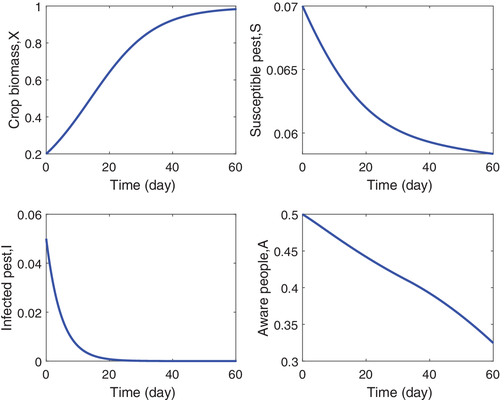
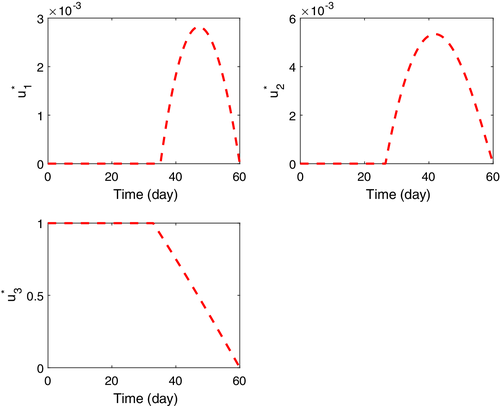
9 CONCLUSIONS
In this article, a mathematical model, described by a system of ordinary differential equations, has been developed and analyzed to plan the control of pests in a farming environment. Our model contains four concentrations, specifically, concentration of crop-biomass, density of susceptible pests, infected pests, and population awareness. The model under consideration exhibits four feasible steady state points: the crop-pest free equilibrium point, which is unstable for all parameter values; the pest free equilibrium point; the susceptible pest free equilibrium point, which may exist when the carrying capacity K is greater than the crop biomass X; and the interior equilibrium point. Local stability of the positive interior equilibrium point and local Hopf-bifurcation around it have been studied. We have shown how the dynamics changes with the parameter value (the consumption rate of pest to crops). The dynamical behavior of the system was investigated using stability theory, optimal control theory, and numerical simulations. We assumed that responsive groups take on bio-control, such as the included pest managing, as it is eco-friendly and is fewer injurious to individual health and surroundings. Neighboring awareness movements may be full as comparative to the concentration of susceptible pest available in the crop biomass. We expect that the international issues, disseminated by radio, TV, telephone, internet, and so forth, enlarge the stage of consciousness. Moreover, we have used optimal control theory to provide the price effective outline of bio-pesticides, chemical pesticide costs and a universal alertness movement. We observed the dynamical behavior of the controlled system and the effects of the three controls. This work can be extended in several ways, for example, by introducing time delays in the awareness level of farmers' attitude toward observation of fields and in becoming aware of their farm after campaigns made. Consideration of the crop population as infected and uninfected cases is also another possible extension to the present article, in order to enrich the proposed mathematical model for pest control.
ACKNOWLEDGMENTS
This work is part of first authors' PhD project, carried out at Adama Science and Technology University (ASTU), Ethiopia. Abraha acknowledges ASTU for its welcome and bear during this work, through the research grant ASTU/SP-R/027/19. Torres is grateful to the financial support from the Portuguese Foundation for Science and Technology (FCT), through CIDMA and project UIDB/04106/2020.
Biographies

Teklebirhan Abraha received his BSc degree in Applied Mathematics from the University of Gondar, Ethiopia, in July 2006, and an MSc degree in Applied Mathematics (Optimization) from Addis Ababa University, Ethiopia, in January 2011. He is currently a PhD candidate in Applied Mathematics (Optimization) at Adama Science and Technology University, Ethiopia, under the supervision of Professor Delfim F. M. Torres and Dr. Legesse Lemecha. His research interests are in the areas of applied mathematics, including optimization and optimal control, mathematical modeling of biological systems, and operations research.

Fahad Al Basir is an Assistant Professor, Department of Mathematics, Asansol Girls' College, West Bengal, India. He received BSc, MSc, and PhD degrees from Jadavpur University, Kolkata, India. He joined, as a Post-Doctoral fellow at the Department of Zoology, Visva-Bharati University, Santiniketan, India. He received Dr. D.S. Kothari Post-Doctoral Fellowship, University Grants Commission, from the Government of India. He is serving as an academic editor of Modelling and Simulation in Engineering, an Hindawi publication. He has authored and co-authored several research articles in reputed journals. His research includes mathematical modeling using ordinary and delay differential equations in disease and pest management, chemical and biochemical systems, and ecology.

Legesse Lemecha Obsu is an Associate Professor of Mathematics and a dean of Postgraduate program at Adama Science and Technology University, Ethiopia. He received MSc and PhD degrees in Mathematics from Addis Ababa University. From 1995 to 1999, he was an undergraduate student at the then Kotebe College of Teachers Education. He has authored and co-authored several research articles in reputed journals. His area of research is mainly focused on mathematical modeling, including traffic flow, epidemiology (infectious diseases), and ecology.

Delfim F. M. Torres is a Portuguese Mathematician born August 16, 1971 in Nampula, Portuguese Mozambique. He obtained a PhD in Mathematics from University of Aveiro (UA) in 2002, and Habilitation in Mathematics, UA, in 2011. He is a Full Professor of Mathematics, since March 9, 2015, Director of the R&D Unit CIDMA, the largest Portuguese research center in Mathematics, and Coordinator of its Systems and Control Group. His main research area is calculus of variations and optimal control; optimization; fractional derivatives and integrals; dynamic equations on time scales; and mathematical biology. Torres has written outstanding scientific and pedagogical publications. In particular, he is author of two books with Imperial College Press and three books with Springer. He has strong experience in graduate and post-graduate student supervision and teaching in mathematics. Twenty PhD students in Mathematics have successfully finished under his supervision. Moreover, he has been team leader and member in several national and international R&D projects, including EU projects and networks. Prof. Torres is a Highly Cited Researcher in Mathematics, having been awarded the title in 2015, 2016, 2017, and 2019. He is, since 2013, the Director of the Doctoral Programme Consortium in Applied Mathematics (MAP-PDMA) of Universities of Minho, Aveiro, and Porto. Delfim is married since 2003, and has one daughter and two sons.




